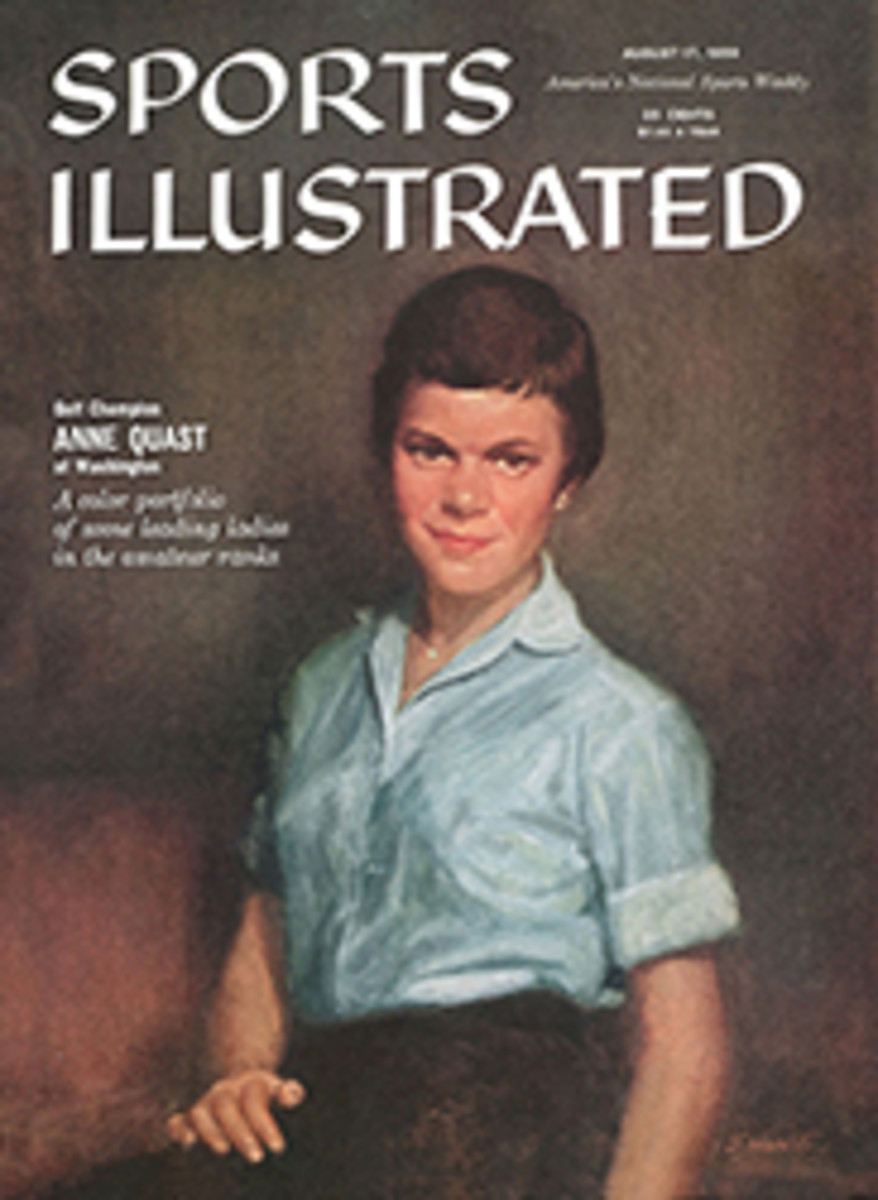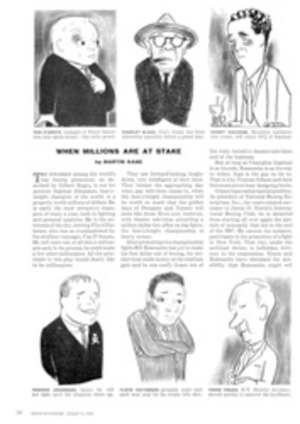
ORDONEZ vs. DOMINGUIN
A squat middle-aged man in a rumpled white suit rose from his barrera seat, jabbed his right fist high in the air and shook it hard. In a voice harsh with accusation he bellowed at two figures standing not ten feet away from me in the callejón: "¬°Ya ha llegado la hora de la verdad! [The moment of truth has finally arrived.]"
It was a challenge, not a statement, and the man in white was speaking for every one of the 12,000 aficionados who had gathered in the Valencia bull ring on this Thursday, the 30th of July, 1959. For this was bullfighting's most important moment in more than a decade—since August 28, 1947, when a hawk-nosed, mournful matador named Manolete was fatally gored in a hick town named Linares. Today was the day the world's two greatest matadors—and greatest rivals—first were to meet on the sands, alone.
The older of the two had known the strain of hard dueling before. He was Luis Miguel Gonzales Lucas Dominguín, 33, who 11 years ago had challenged the great Manolete, had fought and won at Linares the day that Manolete fought and died. The younger was Luis Miguel's brother-in-law, Antonio Ordó√±ez, 27, perhaps the purest artist yet produced by the classic soberness of the Ronda school.
Last year both matadors had the finest season of their careers, and Spain was split between ordo√±istas and dominguístas. But it seemed improbable that they ever would meet because of an old family feud that persisted even after Ordó√±ez married Luis Miguel's sister.
In April, however, the feud was resolved, and in June a series of cartels matched the two masters. At Zaragoza, Luis Miguel cut three ears, Ordó√±ez one. In Barcelona the result was the same, and again at Puerto de Santa María. The luck changed at Tudela—Ordó√±ez cut four ears, Dominguín none. This brought them to Valencia and Tuesday, July 28. If they fought well on that date, a mano a mano—an admitted and open duel on the sands with each matador taking three bulls—would be scheduled for Thursday, July 30. Ordó√±ez cut two ears, Dominguín none, but the crowd was wildly enthusiastic and the mano a mano was scheduled.
On Thursday afternoon I stood behind the burladero of the Valencia ring, watching the open door of the toril with Miguel and Antonio. The first bull was slow coming out, and Luis Miguel, seeing nothing to be gained by waiting behind the burladero, strode out into the ring, shouting to his assistants: "¬°Vale! vale! vale! [O.K., that's enough]." Miguel brought the bull through the cape for two verónicas ("¬°Olé!") topped off by a media-verónica. When it was time for the faena, Luis Miguel started with derechazos, switched to his left hand for naturales, then went back to the right-handed passes and even did a couple on one knee. With a gusty wind getting stronger, Dominguín decided to call it quits, and killed well after one pinchazo.
Ordó√±ez's first bull also walked out of the toril slowly, and the crowd whistled its disapproval. But suddenly the bull charged, chasing everyone in the ring to shelter. Antonio tried a couple of verónicas, but the bull wasn't with him. Ordó√±ez came up to the fence, shaking his head, saying "muy mal, muy mat," but when the banderillas were in, he walked out as if this toro were the best ever. He opened with five estatuarios ("¬°Olé!"), then eight spectacular redondos, and the crowd went wild with delight. Ernest Hemingway, standing next to me behind the burladero, couldn't help beaming. "This bull's got all the defects in the world," said Papa, "and this boy just owns him now." After more right-handed passes in the high wind, Ordó√±ez killed with one stroke and cut an ear.
The third bull charged out fast and to its left, to the sombra side of the ring. Miguel met it with verónicas ("¬°Olé!"), then took it out to the center of the ring for three more magnificent verónicas, to the strongest olés of the day.
After the picadors and banderilleros had their innings Dominguín took the muleta and—close to the barrera-did six derechazos, the last four in rhythmic sequence ("¬°Olé!" and applause). Then he switched to the left hand, for seven good naturales and a pase de pecho. Three manoletinas ("¬°Olé!"), and Miguel was ready to kill. But the sword hit bone three times before he finally got it in. I said to Miguel as he walked up to the barrera, "Too many bones today." He answered gracefully, "I'm surprised I have any left in my sword hand."
The fourth bull was dangerous, and the wind was high, and Ordó√±ez did only perfunctory passes before killing it with one thrust. It was now 7:40 p.m., and the sky was so black that lights had to be turned on over the ring. The bugle blew, and out came the fifth bull of the day—a big black, branded No. 122. It walked out slowly, then charged hard. Dominguín, standing at the barrera, met No. 122 with verónicas and then brought it up to the picador. With a flick of its great neck, the bull dumped both horse and rider.
Luis Miguel called for agua to give his muleta weight against the wind, then started with estatuarios at the fence. He quickly switched to doubling passes to wear down some of the bull's terrible strength, then went back to estatuarios. Three derechazos, and No. 122 hooked the muleta out of the maestro's hand. Miguel retrieved it and started another series of derechazos, trying to teach the bull to follow smoothly. On the fourth pass Dominguín was suddenly no longer standing by the bull. He was on the ground. Luis Miguel tried to get up, but the horns caught him before a flurry of capes could bring No. 122 away. There were screams in the crowd. Nobody could quite believe it—Dominguín gored! As Miguel was carried to the infirmary, gravely wounded, his brother-in-law stepped out to finish off his bull with one thrust.
The last bull was the best of the feria. It charged out of the toril like good bulls should, charged honestly and smoothly as Ordó√±ez gave it a dozen tremendous verónicas. After one bout with the picadors, Antonio asked for banderillas. When the sticks were in, Antonio grabbed the muleta, made a quick dedication and actually ran out to meet the bull. Four magnificent erect estatuarios ("¬°Olé!") were followed by a faena built around the right hand—each pass slower, closer, more beautiful than the one before. There were series after series of derechazos, each capped by a slow, graceful pase de pecho. Then came manoletinas, a more spectacular pass than the derechazo, but overused by almost everyone except Ordó√±ez. Every pass in the faena was in rhythmic harmony with the others. Hemingway was delirious, and so was I. "I told you he's the greatest," shouted Hemingway. "He's probably the greatest bullfighter the world has ever seen. He's the greatest I've ever seen." The crowd forced the president to award Ordó√±ez both ears even though he hit bone once before the final estocada.
PHOTO
DOWN IN THE DUST Luis Miguel is pummeled by the savage bull branded No. 122.

